Organizations looking to stay competitive must use AI for operational efficiency; it is no longer a sci-fi idea. Businesses can use artificial intelligence to automate repetitive operations, streamline processes, and make data-driven decisions that promote productivity and expansion.
The advantages of artificial intelligence (AI) and emerging trends for operational efficiency are all covered in this blog.
Pro-tip
If you want to improve efficiency and stay competitive, leverage AI in your operations. Automate repetitive tasks, integrate data systems, and use AI-driven analytics to make smarter decisions in real-time. Businesses that embrace AI see reduced costs, increased productivity, and a more agile approach to market changes—don’t wait to implement these solutions.
Key Challenges in Traditional Operational Practices
Before diving into how AI enhances operational efficiency, it’s important to understand the existing challenges businesses face with traditional operational methods. These challenges create inefficiencies, increase costs, and hinder growth.
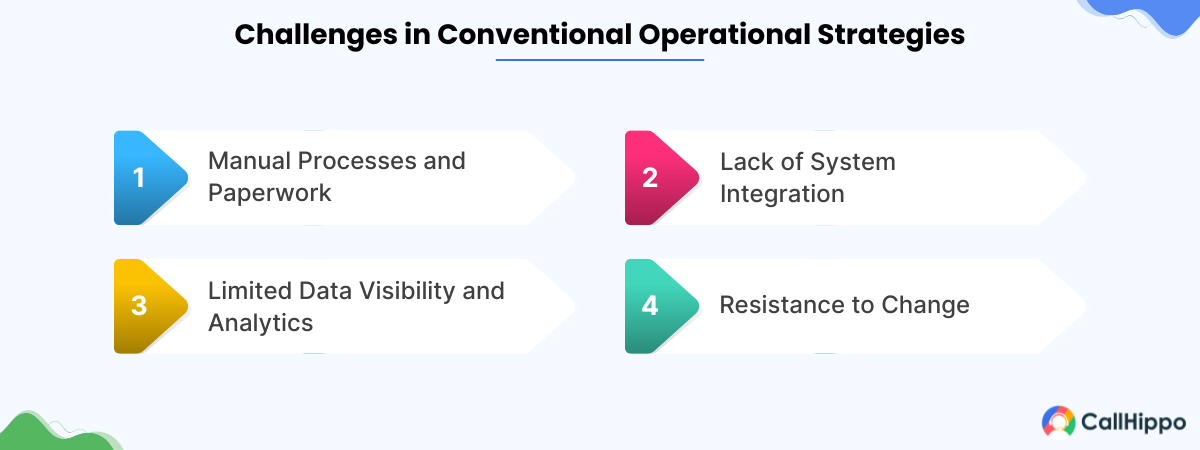
1. Manual Processes and Paperwork
Many businesses still rely on manual workflows, which are time-consuming, error-prone, and resource-intensive. From processing invoices to managing inventory, manual tasks slow down operations and increase the risk of human error.
Paper-based documentation further adds to inefficiencies, making it difficult to track and retrieve essential data.
2. Lack of System Integration
A significant hurdle for many organizations is the lack of seamless integration between different business systems. Legacy software, disconnected databases, and fragmented workflows prevent smooth data exchange, leading to inefficiencies and miscommunication.
Without integration, teams spend valuable time manually transferring information between systems, increasing the risk of discrepancies.
For Example
- Amazon’s supply chain success is largely attributed to AI-driven integration, reducing inventory costs while ensuring timely deliveries.
3. Limited Data Visibility and Analytics
Data is a powerful asset, but without proper analytics and visibility, businesses struggle to make informed decisions. Traditional operations cannot often analyze real-time data, leading to guesswork instead of data-driven strategies. Limited visibility into key performance metrics makes it difficult for businesses to optimize operations effectively.
Companies like Walmart leverage AI-powered analytics to track inventory in real-time, reducing waste and optimizing stocking strategies.
4. Resistance to Change and Reliance on Legacy Systems
Many organizations resist adopting new technologies due to fear of change, high implementation costs, or a lack of understanding of AI’s potential. Additionally, reliance on outdated legacy systems prevents businesses from leveraging AI-driven automation and analytics. Companies that fail to adapt risk falling behind competitors that embrace AI-powered efficiency.
General Electric faced similar challenges but overcame them by investing in AI-driven predictive maintenance, which reduced operational costs and increased efficiency.
4 Key Benefits of AI in Operational Efficiency
AI is crucial for businesses looking to overcome these traditional challenges. From automating tasks to enhancing decision-making, AI brings numerous benefits that drive operational efficiency.
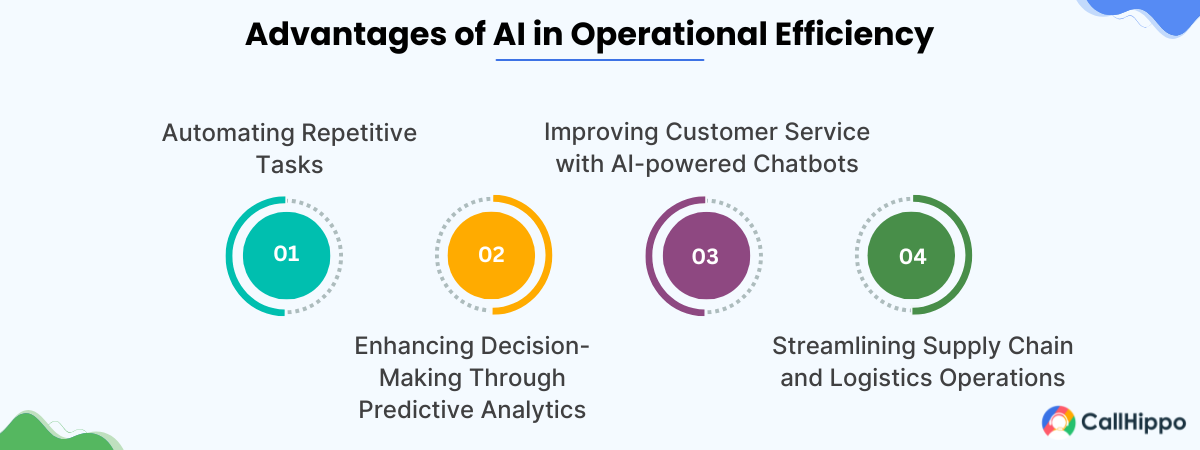
1. Automating Repetitive Tasks to Save Time and Resources
AI automates repetitive tasks such as data entry, invoice processing, and customer inquiries, allowing employees to focus on higher-value work. Automation reduces errors, speeds up processes, and enhances productivity.
By streamlining operations, AI-powered tools help businesses reduce operational costs and optimize resource allocation. Companies can integrate AI into their workflow management systems to ensure seamless task execution, ultimately leading to greater efficiency and profitability.
For Example
- JPMorgan Chase implemented an AI-driven document review system that processes thousands of contracts in seconds, reducing workload significantly.
2. Enhancing Decision-Making Through Predictive Analytics
Predictive analytics powered by AI helps businesses make informed decisions by analyzing historical data and identifying patterns. Companies can use AI to forecast inventory demand, detect fraudulent transactions, and optimize resource allocation. Netflix uses AI-driven analytics to personalize recommendations, improving customer engagement and retention.
With real-time insights, organizations can proactively address challenges, mitigate risks, and improve overall operational efficiency. AI-driven analytics tools enable data-driven strategies, empowering businesses to make accurate decisions that enhance productivity, profitability, and market competitiveness.
3. Improving Customer Service with AI-powered Chatbots
AI-powered chatbots and virtual assistants improve customer service by providing instant, accurate responses and handling multiple inquiries simultaneously. These AI-driven solutions ensure 24/7 support, reducing wait times and enhancing customer satisfaction.
Businesses benefit from cost savings as chatbots handle routine queries, allowing human agents to focus on complex issues. Personalized AI-driven interactions enhance customer engagement and loyalty. As AI chatbots continue to advance, they will further refine natural language processing capabilities, making customer interactions even more seamless and intuitive.
4. Streamlining Supply Chain and Logistics Operations
AI optimizes supply chain operations by improving demand forecasting, route planning, and inventory management. Businesses use AI-driven analytics to predict demand fluctuations, prevent stockouts, and reduce excess inventory costs. AI-powered logistics solutions optimize delivery routes, lowering transportation expenses and ensuring timely shipments.
By integrating AI with IoT devices, businesses can achieve real-time tracking, proactive issue resolution, and enhanced supply chain visibility. These advancements result in cost savings, improved efficiency, and a more agile supply chain that can quickly adapt to changing market conditions.
Boost Your Operational Efficiency
with AI Today!
- AI-driven lead engagement
- Smart call analytics
- Fraud Prevention & Enhanced Security
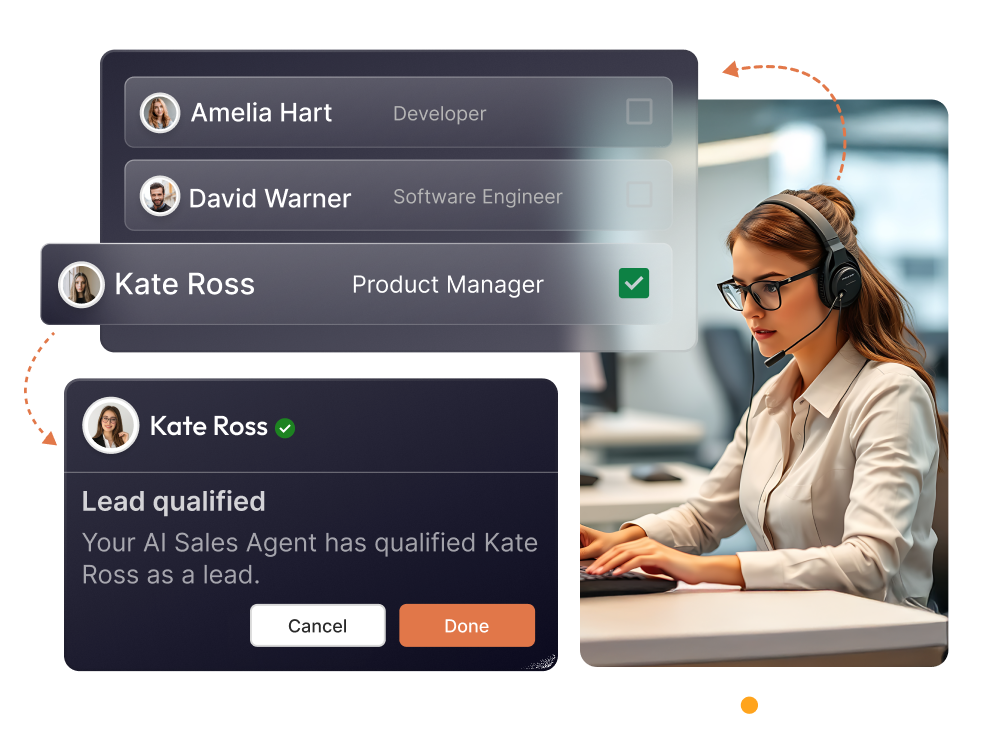
6 Key Use Cases of AI for Operational Efficiency Across Industries
AI’s impact extends across various industries, transforming how businesses operate and deliver value to customers. Here are some industry-specific applications of AI operational efficiency.
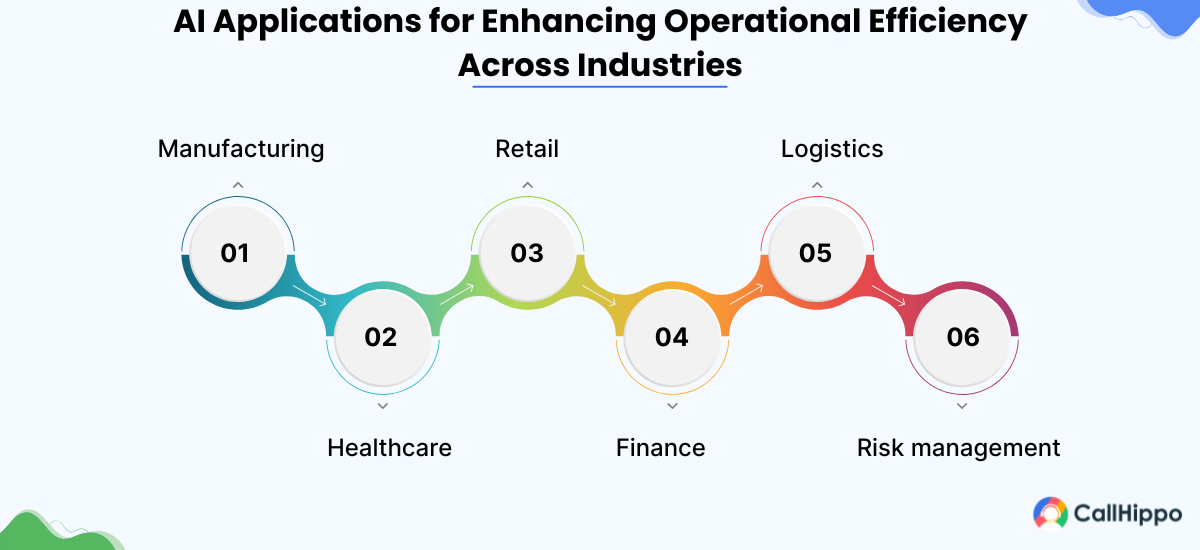
1. Manufacturing: Predictive Maintenance and Quality Control
AI helps manufacturers prevent costly breakdowns by analyzing sensor data and predicting equipment failures before they happen. This proactive approach reduces downtime, lowers repair costs, and extends the lifespan of machinery. AI also improves quality control by identifying defects in products during production, ensuring consistency, and reducing waste.
Machine learning algorithms can detect even the smallest inconsistencies, improving overall product reliability. With AI, manufacturers can automate inspections, increase efficiency, and maintain high-quality standards while reducing human error. This leads to a smoother production process, higher customer satisfaction, and increased profitability for manufacturing businesses.
2. Healthcare: Optimizing Patient Care and Resource Allocation
AI is transforming healthcare by improving diagnosis, automating tasks, and optimizing resource distribution. AI-powered diagnostic tools analyze medical images and patient data to detect diseases earlier and with greater accuracy.
Hospitals use AI-driven scheduling systems to allocate staff, beds, and equipment efficiently, reducing wait times and improving patient outcomes. Virtual health assistants powered by AI can provide medical advice, track symptoms, and support patients remotely.
By streamlining administrative processes and improving decision-making, AI helps healthcare professionals focus on patient care, leading to faster treatments, better resource management, and an overall increase in healthcare efficiency.
3. Retail: Inventory Management and Personalized Customer Experiences
Retailers use AI to manage inventory efficiently, ensuring products are always available while reducing overstock and waste. AI-powered demand forecasting analyzes shopping trends, weather patterns, and sales history to predict stock needs accurately. AI also enhances customer experience by personalizing recommendations based on browsing history and purchase behavior.
Chatbots and virtual assistants help customers find products, answer queries, and improve engagement. AI-driven marketing strategies tailor promotions to individual preferences, boosting sales and customer satisfaction. With AI, retailers can optimize operations, enhance customer loyalty, and stay competitive in a rapidly evolving market.
4. Finance: Fraud Detection and Compliance Automation
AI strengthens financial security by detecting fraud in real-time. Machine learning models analyze transaction patterns to identify unusual activities, preventing fraudulent transactions before they occur. Banks and financial institutions also use AI to automate compliance processes, ensuring adherence to regulations and reducing the risk of costly penalties.
AI-driven tools scan vast amounts of financial data to flag potential risks, helping businesses meet legal requirements effortlessly. Chatbots and virtual assistants improve customer service by answering queries and handling routine transactions. AI makes the financial industry more secure, efficient, and customer-friendly.
5. Logistics: Route Optimization and Delivery Tracking
AI optimizes logistics by determining the fastest and most efficient delivery routes. It analyzes real-time traffic, weather conditions, and historical data to reduce delays and fuel costs. AI-powered tracking systems provide customers with accurate, real-time shipment updates, improving transparency and satisfaction. Automated warehouse systems use AI to streamline inventory management, ensuring faster order fulfillment.
Drones and autonomous vehicles powered by AI are also transforming last-mile delivery, making it quicker and more cost-effective. By integrating AI, logistics companies can improve efficiency, reduce costs, and enhance customer experience, making supply chains more resilient and responsive.
6. Risk management: AI-driven Risk Assessment and Mitigation
AI enhances risk management by analyzing data to identify threats before they escalate. Businesses use AI-powered tools to assess financial risks, predict market fluctuations, and monitor cybersecurity threats. AI algorithms detect suspicious activities and potential fraud, helping companies take preventive measures.
By leveraging AI, organizations can make data-driven decisions, minimize financial losses, and maintain operational stability. AI-driven risk management ensures proactive responses to uncertainties, making businesses more resilient in an unpredictable environment.
Implementing AI for Operational Efficiency
Adopting AI requires a strategic approach to ensure successful implementation and maximize its benefits. Here’s how businesses can effectively integrate AI into their operations:
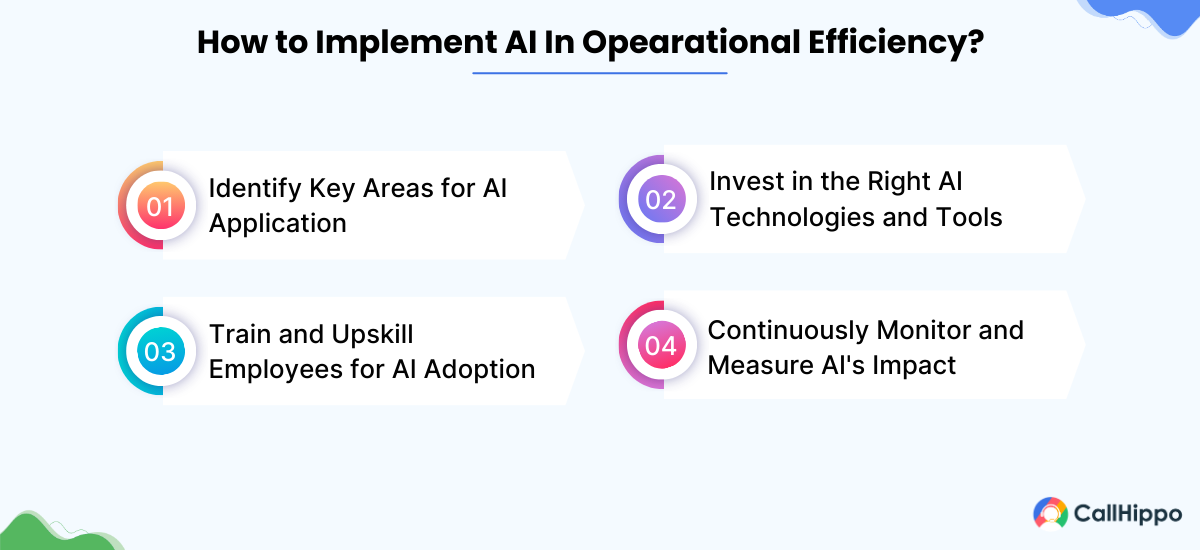
1. Identify Key Areas for AI Application
Businesses should assess their current operations to identify areas where AI can have the most impact. Whether it’s automating customer service, optimizing supply chain management, or enhancing decision-making, defining clear objectives is essential for a successful AI strategy.
For instance, Starbucks leverages AI in its mobile ordering system, reducing wait times and improving customer experience.
2. Invest in the Right AI Technologies and Tools
Choosing the right AI tools and technologies is crucial for successful implementation. Businesses should evaluate AI solutions based on scalability, ease of integration, and alignment with their operational needs. Partnering with AI providers and leveraging cloud-based AI platforms can streamline deployment.
3. Train and Upskill Employees for AI Adoption
Employee buy-in is critical for AI adoption. Organizations should invest in training programs to help employees understand AI’s capabilities, address concerns, and develop AI-related skills. Encouraging collaboration between AI systems and human workers ensures smooth integration.
Google offers AI training programs for employees to ensure the smooth adoption of AI-driven workflows.
4. Continuously Monitor and Measure AI’s Impact on Operations
Businesses should regularly evaluate AI’s performance by tracking key performance indicators (KPIs) such as cost savings, improving agent productivity, and customer satisfaction. Continuous monitoring allows organizations to refine AI strategies and optimize their impact over time.
Real-World Examples of AI Driving Operational Efficiency
Many organizations have successfully integrated AI into their operations. Here are two notable case studies:
1. Axis Bank: Enhancing customer service with AI voice assistants
Axis Bank implemented AI-powered voice assistants to handle customer inquiries and automate routine banking tasks. This reduced wait times, improved customer satisfaction, and freed up human agents for more complex issues.
2. Cleveland Clinic: Optimizing healthcare operations with AI
Cleveland Clinic leveraged AI to optimize patient scheduling, resource allocation, and predictive analytics for patient care. AI-driven insights improved operational efficiency, reduced administrative burdens, and enhanced patient outcomes.
4 Main Future Trends in AI for Operational Efficiency
AI continues to evolve, shaping the future of business operations. Key trends include.
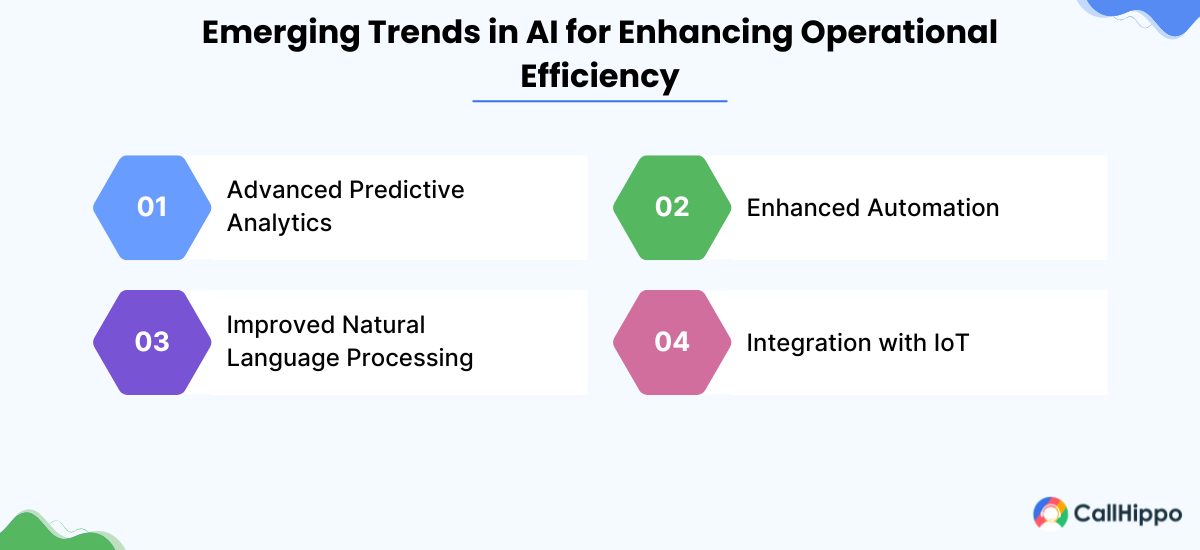
1. Advanced Predictive Analytics
AI is getting better at predicting trends and helping businesses make smarter decisions. By analyzing huge amounts of real-time data, AI can accurately forecast customer preferences, market shifts, and operational risks. This means businesses can stay ahead of demand, prevent disruptions, and make proactive choices instead of reacting to problems.
In retail, finance, and healthcare industries, AI-powered predictions will shape everything from personalized marketing to supply chain efficiency. As AI becomes more refined, companies will rely on it to uncover insights that drive growth, reduce costs, and make operations smoother and more efficient.
2. Enhanced Automation
AI is automating tasks that once required human effort, making businesses run more smoothly. From handling customer service chats to processing invoices, AI-powered automation is reducing errors and saving time. Industries like healthcare, manufacturing, and finance are already using AI to speed up repetitive tasks, and the future will bring even more advanced automation.
Robotic Process Automation (RPA) will evolve to handle complex decision-making, freeing up employees to focus on strategy and creativity. As AI continues to improve, businesses will see greater efficiency, lower costs, and a workplace where humans and AI work side by side seamlessly.
3. Improved Natural Language Processing
AI-powered chatbots and virtual assistants are becoming more conversational and natural, making interactions feel more human. Future advancements in Natural Language Processing (NLP) will allow AI to understand emotions, context, and intent better than ever before. This means customer service bots will actually “get” what users are asking, providing more relevant and helpful responses.
Businesses will use AI-driven communication to offer faster, more personalized support, making customer interactions smoother and more engaging. As NLP technology improves, AI assistants will become an everyday part of work and life, handling tasks like scheduling, answering questions, and even summarizing documents.
4. Integration with IoT
AI and the Internet of Things (IoT) are joining forces to create smarter, more connected systems. Imagine machines that predict when they’ll break down before they actually do or warehouses that automatically restock inventory based on real-time demand. AI will analyze data from IoT devices—like sensors in factories, delivery trucks, and smart homes—to optimize operations and prevent issues before they happen.
This technology will improve everything from energy efficiency in buildings to tracking shipments in logistics. As AI and IoT continue to evolve together, businesses will gain real-time insights that make operations faster, safer, and more cost-effective.
Conclusion
The use of AI for business optimization has changed company operations by lowering costs, boosting productivity, and improving decision-making. Companies like Microsoft and Amazon have demonstrated how AI-driven strategies create a significant competitive edge.
By using data-driven insights, streamlining processes, and automating operations, businesses that use AI will have a competitive edge. Companies need to invest in AI solutions, maintain agility, and continuously improve their strategy as AI technology develops in order to maximize success and efficiency.

Let’s Stay in Touch
Subscribe to our newsletter & never miss our latest news and promotions.



